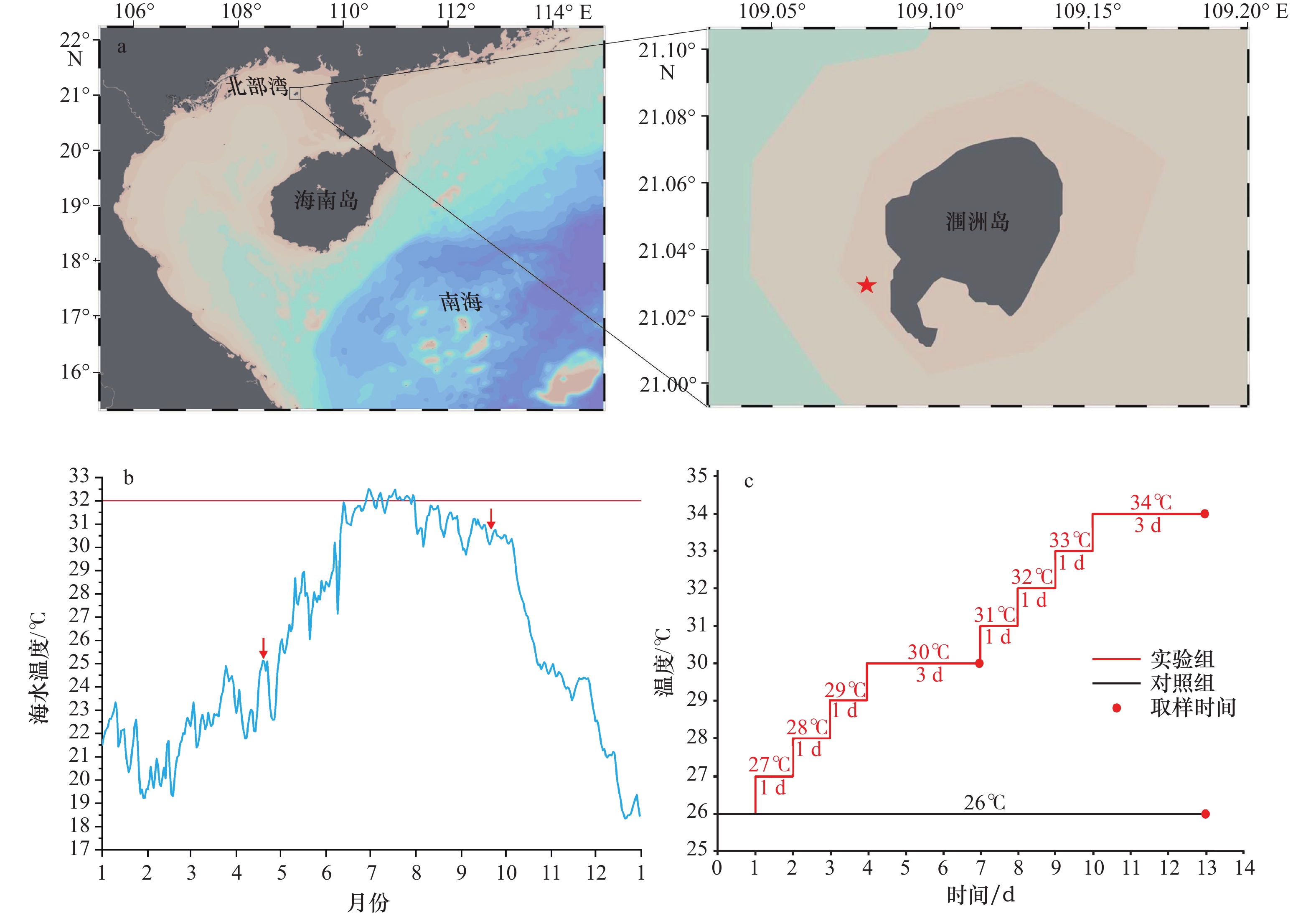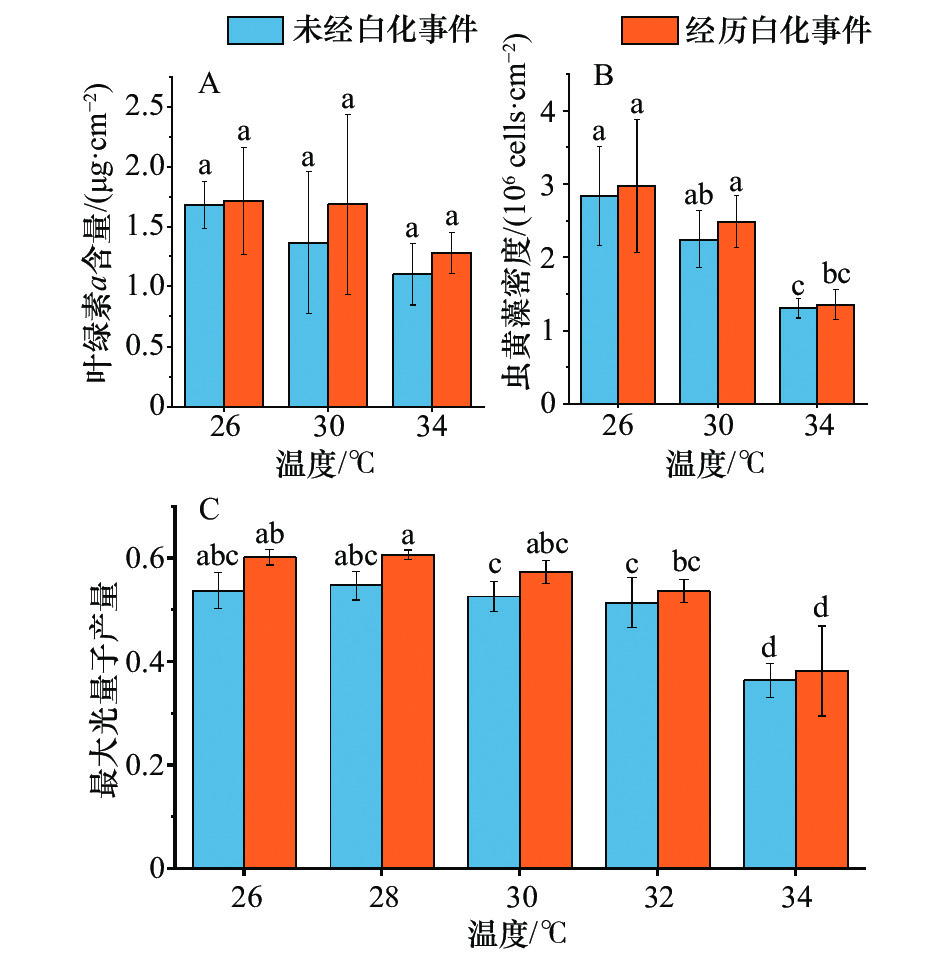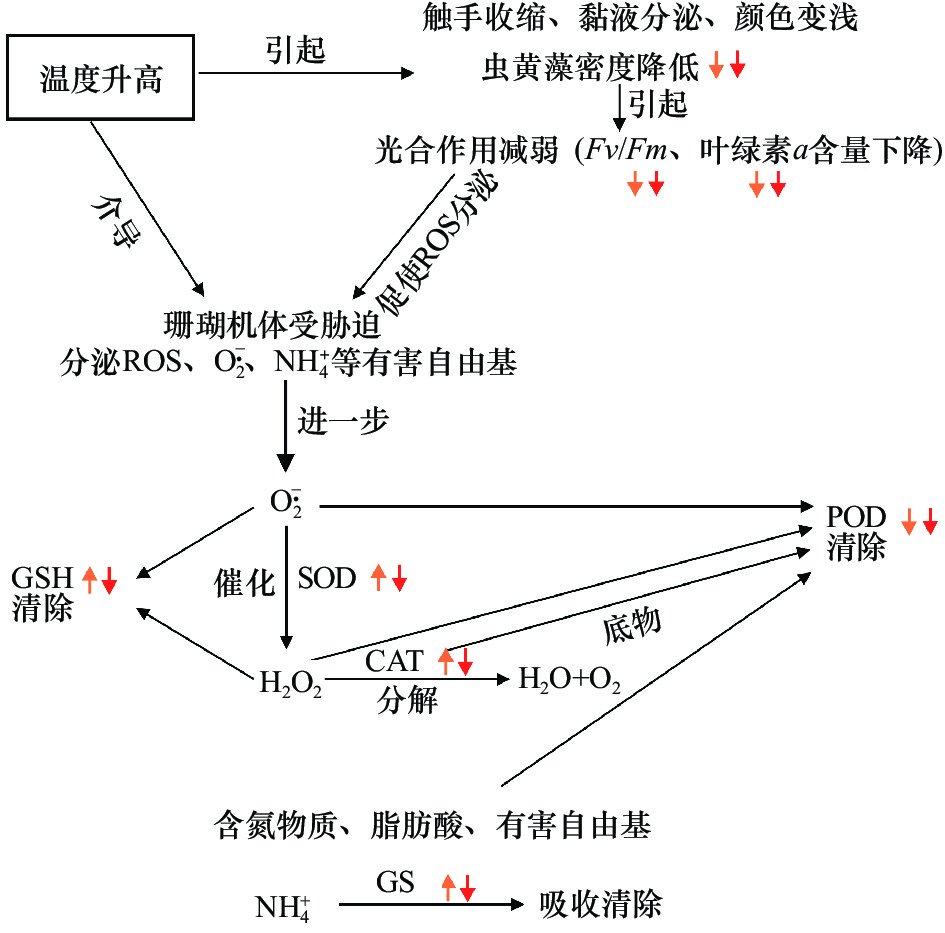High temperature bleaching events can increase thermal tolerance of Porites lutea in the Weizhou Island
-
摘要: 近年来,全球气候变暖引起的海水表层温度上升导致大规模珊瑚白化事件频繁发生,严重损害了珊瑚礁的生态健康。为了揭示白化事件对澄黄滨珊瑚(Porites lutea)耐热性的影响,进一步探索滨珊瑚对高温的生理响应,本研究对广西涠洲岛2020年夏季极端高温白化事件前、后的澄黄滨珊瑚进行了高温胁迫对比实验,并进行了生理生化指标分析。结果显示:(1)两组澄黄滨珊瑚对高温胁迫的响应模式一致,均表现为珊瑚触手收缩,虫黄藻密度、最大光量子产量(Fv/Fm)和叶绿素a含量明显降低,抗氧化物(总超氧化物歧化酶、过氧化氢酶、还原型谷胱甘肽)和铵同化酶(谷氨酰胺合成酶)活性(含量)先升后降;(2)经历高温白化事件后的澄黄滨珊瑚生理指标表现更佳,其抗氧化物和铵同化酶都始终保持高的活性及灵敏的响应。这意味着涠洲岛的澄黄滨珊瑚经历高温白化事件后,可以通过提高抗氧化物和铵同化酶活性来提升耐热性,是其应对全球变暖的策略之一。本研究还揭示了涠洲岛澄黄滨珊瑚应对极端高温的生理响应模式,为珊瑚礁保护和生态修复提供了理论支持。Abstract: In recent years, the rising of sea surface temperature caused by global warming resulted in frequently large-scale coral bleaching events, which have seriously damaged the health of coral reef ecosystems. In order to reveal the influence of bleaching events on the thermal tolerance of Porites lutea and further explore the physiological response of P. lutea in high temperature, comparative study was carried out on high-stress experiment on P. lutea before and after high temperature bleaching events at Weizhou Island, Guangxi in summer 2020. Coral’s physiological and biochemical indexes were also analyzed. The results showed that: (1) the response pattern of the two groups to high temperature stress was that the contraction of coral tentacles, the density of zooxanthellae, the maximum quantum efficiency of Photosystem II (Fv/Fm) and chlorophyll a content decreased significantly, antioxidant (superoxide dismutase, catalase, glutathione) and ammonium assimilase (glutamine synthase) activities (content) increased and then decreased; (2) the physiological indexes showed better performance and its antioxidant and ammonium assimilation enzyme kept high activity and sensitive response in the after high temperature bleaching events group. It means that the P. lutea in the Weizhou Island can improve its thermal tolerance by increasing the activities of antioxidant and ammonium assimilation enzyme after high temperature bleaching events which is one of the strategies to cope with global warming. This study also revealed the response pattern of Weizhou Island’s P. lutea to extreme high temperatures, providing theoretical support for coral reef protection and ecological restoration.
-
Key words:
- Weizhou Island /
- bleaching events /
- Porites lutea /
- high temperature stress /
- global warming
-
图 1 采样区域和实验方法
a. 红色星形为具体采样海域;b. 2020年涠洲岛海水日均温度由HOBO水下温度计实测记录,放置水深为4~6 m,红色箭头指2020年4月底和2020年9月底采样时间;c. 高温胁迫实验设计方法
Fig. 1 Sampling locations and experimental method
a. The red star is the sampling area;b. the average daily seawater temperature of Weizhou Island in 2020 was recorded by HOBO underwater thermometer (4−6 m), the red arrows indicate the sampling time at the end of April and the end of September 2020; c. method of high temperature stress experiment
图 3 两组澄黄滨珊瑚温度胁迫过程中生理指标的变化
误差线为多次重复所得平均值的标准误差,通过单因素ANOVA分析,不同的字母标注表示参数有显著差异(p<0.05)
Fig. 3 Changes of physiological indexes of two groups of Porites lutea under temperature stress
The error line is the standard error of the mean value of multiple repetitions, different letter annotations indicate significant differences by single-factor ANOVA analysis (p<0.05)
图 4 两组澄黄滨珊瑚温度胁迫过程中抗氧化物活性(含量)的变化
误差线为多次重复所得平均值的标准误差,通过单因素ANOVA分析,不同的字母标注表示参数有显著差异(p<0.05)
Fig. 4 Changes of antioxidant activity (content) of two groups of Porites lutea under temperature stress
The error line is the standard error of the mean value of multiple repetitions, different letter annotations indicate significant differences by single-factor ANOVA analysis (p<0.05)
图 5 两组澄黄滨珊瑚温度胁迫过程中铵同化酶(GS)活性的变化
误差线为多次重复所得平均值的标准误差,通过单因素ANOVA分析,不同的字母标注表示参数有显著差异(p<0.05)
Fig. 5 Changes of ammonium assimilation enzyme (GS) activities of two groups of Porites lutea under temperature stress
The error line is the standard error of the mean value of multiple repetitions, different letter annotations indicate significant differences by single-factor ANOVA analysis (p<0.05)
图 6 澄黄滨珊瑚对高温的响应模式
橙黄色、红色箭头分别代表30℃第3天和34℃第3天相应指标值的变化,箭头方向则代表升降趋势
Fig. 6 Response pattern of Porites lutea to high temperature
The orange and red arrows represent the changes of corresponding indexs on the third day at 30℃ and 34℃ respectively, and the arrow directions represent the ascending and descending trend
-
[1] Moberg F, Folke C. Ecological goods and services of coral reef ecosystems[J]. Ecological Economics, 1999, 29(2): 215−233. doi: 10.1016/S0921-8009(99)00009-9 [2] 赵美霞, 余克服, 张乔民. 珊瑚礁区的生物多样性及其生态功能[J]. 生态学报, 2006, 26(1): 186−194. doi: 10.3321/j.issn:1000-0933.2006.01.025Zhao Meixia, Yu Kefu, Zhang Qiaomin. Review on coral reefs biodiversity and ecological function[J]. Acta Ecologica Sinica, 2006, 26(1): 186−194. doi: 10.3321/j.issn:1000-0933.2006.01.025 [3] Hoegh-Guldberg O, Kennedy E V, Beyer H L, et al. Securing a long-term future for coral reefs[J]. Trends in Ecology & Evolution, 2018, 33(12): 936−944. [4] Hughes T P, Anderson K D, Connolly S R, et al. Spatial and temporal patterns of mass bleaching of corals in the Anthropocene[J]. Science, 2018, 359(6371): 80−83. doi: 10.1126/science.aan8048 [5] Higuchi T, Yuyama I, Nakamura T. The combined effects of nitrate with high temperature and high light intensity on coral bleaching and antioxidant enzyme activities[J]. Regional Studies in Marine Science, 2015, 2: 27−31. doi: 10.1016/j.rsma.2015.08.012 [6] McLachlan R H, Price J T, Solomon S L, et al. Thirty years of coral heat-stress experiments: a review of methods[J]. Coral Reefs, 2020, 39(4): 885−902. doi: 10.1007/s00338-020-01931-9 [7] Wright R M, Mera H, Kenkel C D, et al. Positive genetic associations among fitness traits support evolvability of a reef-building coral under multiple stressors[J]. Global Change Biology, 2019, 25(10): 3294−3304. doi: 10.1111/gcb.14764 [8] Yu Xiaopeng, Yu Kefu, Huang Wen, et al. Thermal acclimation increases heat tolerance of the scleractinian coral Acropora pruinosa[J]. Science of the Total Environment, 2020, 733: 139319. doi: 10.1016/j.scitotenv.2020.139319 [9] Maynard J A, Anthony K R N, Marshall P A, et al. Major bleaching events can lead to increased thermal tolerance in corals[J]. Marine Biology, 2008, 155(2): 173−182. doi: 10.1007/s00227-008-1015-y [10] Thompson D M, van Woesik R. Corals escape bleaching in regions that recently and historically experienced frequent thermal stress[J]. Proceedings of the Royal Society B: Biological Sciences, 2009, 276(1669): 2893−2901. doi: 10.1098/rspb.2009.0591 [11] Harrison H B, Álvarez-Noriega M, Baird A H, et al. Back-to-back coral bleaching events on isolated atolls in the Coral Sea[J]. Coral Reefs, 2019, 38(4): 713−719. doi: 10.1007/s00338-018-01749-6 [12] Middlebrook R, Hoegh-Guldberg O, Leggat W. The effect of thermal history on the susceptibility of reef-building corals to thermal stress[J]. Journal of Experimental Biology, 2008, 211: 1050−1056. doi: 10.1242/jeb.013284 [13] 刘旭. 造礁石珊瑚对温度胁迫的响应机制研究[D]. 南宁: 广西大学, 2020.Liu Xu. The response mechanisms of scleractinian coral to temperature stress[D]. Nanning: Guangxi University, 2020. [14] 王文欢. 近30年来北部湾涠洲岛造礁石珊瑚群落演变及影响因素[D]. 南宁: 广西大学, 2017.Wang Wenhuan. Evolvement and influential factors of coral community over past three decases in Weizhou Island Reef, Beibu Gulf[D]. Nanning: Guangxi University, 2017. [15] Yu Xiaopeng, Yu Kefu, Chen Biao, et al. Different responses of scleractinian coral Acropora pruinosa from Weizhou Island during extreme high temperature events[J]. Coral Reefs, 2021, 40(6): 1697−1711. doi: 10.1007/s00338-021-02182-y [16] 牛文涛, 田鹏, 林荣澄, 等. 蓝碧海峡澄黄滨珊瑚群体遗传多样性[J]. 应用海洋学学报, 2015, 34(3): 419−426. doi: 10.3969/j.issn.2095-4972.2015.03.015Niu Wentao, Tian Peng, Lin Rongcheng, et al. Genetic structure of ITS gene sequence of Porites lutea populations in Lembeh Strait[J]. Journal of Applied Oceanography, 2015, 34(3): 419−426. doi: 10.3969/j.issn.2095-4972.2015.03.015 [17] Jeffrey S W, Humphrey G F. New spectrophotometric equations for determining chlorophylls a, b, c1 and c2 in higher plants, algae and natural phytoplankton[J]. Biochemie Und Physiologie Der Pflanzen, 1975, 167(2): 191−194. doi: 10.1016/S0015-3796(17)30778-3 [18] Tang Jia, Ni Xingzhen, Zhou Zhi, et al. Acute microplastic exposure raises stress response and suppresses detoxification and immune capacities in the scleractinian coral Pocillopora damicornis[J]. Environmental Pollution, 2018, 243: 66−74. doi: 10.1016/j.envpol.2018.08.045 [19] Zhou Zhi, Ni Xingzhen, Wu Zhongjie, et al. Physiological and transcriptomic analyses reveal the threat of herbicides glufosinate and glyphosate to the scleractinian coral Pocillopora damicornis[J]. Ecotoxicology and Environmental Safety, 2022, 229: 113074. doi: 10.1016/j.ecoenv.2021.113074 [20] 李淑, 余克服, 施祺, 等. 海南岛鹿回头石珊瑚对高温响应行为的实验研究[J]. 热带地理, 2008, 28(6): 534−539. doi: 10.3969/j.issn.1001-5221.2008.06.009Li Shu, Yu Kefu, Shi Qi, et al. Experimental study of stony coral response to the high temperature in Luhuitou of Hainan Island[J]. Tropical Geography, 2008, 28(6): 534−539. doi: 10.3969/j.issn.1001-5221.2008.06.009 [21] Meikle P, Richards G N, Yellowlees D. Structural investigations on the mucus from six species of coral[J]. Marine Biology, 1988, 99(2): 187−193. doi: 10.1007/BF00391980 [22] Hinrichs S, Patten N L, Waite A M. Temporal variations in metabolic and autotrophic indices for Acropora digitifera and Acropora spicifera—implications for monitoring projects[J]. PLoS One, 2013, 8(5): e63693. doi: 10.1371/journal.pone.0063693 [23] 张海洋, 赵美霞, 钟瑜, 等. 南海北部造礁石珊瑚共生体光合作用特征季节性监测[J]. 海洋地质前沿, 2021, 37(6): 84−91.Zhang Haiyang, Zhao Meixia, Zhong Yu, et al. Seasonal monitoring of photosynthesis characteristics of scleractinian corals in the northern South China Sea[J]. Marine Geology Frontiers, 2021, 37(6): 84−91. [24] Hoegh-Guldberg O. Climate change, coral bleaching and the future of the world’s coral reefs[J]. Marine and Freshwater Research, 1999, 50(8): 839−866. [25] Downs C A, Mueller E, Phillips S, et al. A molecular biomarker system for assessing the health of coral (Montastraea faveolata) during heat stress[J]. Marine Biotechnology, 2000, 2(6): 533−544. doi: 10.1007/s101260000038 [26] Moya A, Sakamaki K, Mason B M, et al. Functional conservation of the apoptotic machinery from coral to man: the diverse and complex Bcl-2 and caspase repertoires of Acropora millepora[J]. BMC Genomics, 2016, 17(1): 62. doi: 10.1186/s12864-015-2355-x [27] Bhagooli R, Hidaka M. Photoinhibition, bleaching susceptibility and mortality in two scleractinian corals, Platygyra ryukyuensis and Stylophora pistillata, in response to thermal and light stresses[J]. Comparative Biochemistry and Physiology Part A: Molecular & Integrative Physiology, 2004, 137(3): 547−555. [28] Cziesielski M J, Schmidt-Roach S, Aranda M. The past, present, and future of coral heat stress studies[J]. Ecology and Evolution, 2019, 9(17): 10055−10066. doi: 10.1002/ece3.5576 [29] Fridovich I. Superoxide anion radical ( $ { {\text{O}}_2^{\frac{{}}{ \bullet }}} $ ), superoxide dismutases, and related matters[J]. Journal of Biological Chemistry, 1997, 272(30): 18515−18517. doi: 10.1074/jbc.272.30.18515[30] 王小巍, 张红艳, 刘锐, 等. 谷胱甘肽的研究进展[J]. 中国药剂学杂志(网络版), 2019, 17(4): 141-148.Wang Xiaowei, Zhang Hongyan, Liu Rui, et al. Progress in research of glutathione[J]. Chinese Journal of Pharmaceutics (Online Edition), 17(4): 141−148. [31] 董金龙. 金银花中过氧化物酶的纯化及性质研究[D]. 洛阳: 河南科技大学, 2017.Dong Jinlong. Study on purification and characterisation of peroxidase from Honeysuckle[D]. Luoyang: Henan University of Science and Technology, 2017. [32] Gates R D, Baghdasarian G, Muscatine L. Temperature stress causes host cell detachment in symbiotic cnidarians: implications for coral bleaching[J]. The Biological Bulletin, 1992, 182(3): 324−332. doi: 10.2307/1542252 [33] Perez S, Weis V. Nitric oxide and cnidarian bleaching: an eviction notice mediates breakdown of a symbiosis[J]. Journal of Experimental Biology, 2006, 209(14): 2804−2810. doi: 10.1242/jeb.02309 [34] Su Yilu, Zhou Zhi, Yu Xiaopeng. Possible roles of glutamine synthetase in responding to environmental changes in a scleractinian coral[J]. Molecular Biology Reports, 2018, 45(6): 2115−2124. doi: 10.1007/s11033-018-4369-3 [35] Rädecker N, Pogoreutz C, Gegner H M, et al. Heat stress destabilizes symbiotic nutrient cycling in corals[J]. Proceedings of the National Academy of Sciences of the United States of America, 2021, 118(5): e2022653118. doi: 10.1073/pnas.2022653118 [36] 晁华, 申玉春, 刘丽. 氮磷对珊瑚过氧化氢酶和超氧化物歧化酶活性的影响[J]. 中国农学通报, 2016, 32(17): 12−19. doi: 10.11924/j.issn.1000-6850.casb16010084Chao Hua, Shen Yuchun, Liu Li. Nitrogen and phosphorus affecting activities of catalase and superoxide dismutase in coral[J]. Chinese Agricultural Science Bulletin, 2016, 32(17): 12−19. doi: 10.11924/j.issn.1000-6850.casb16010084 [37] 许惠丽, 冯博轩, 谢敏睿, 等. 三亚蜈支洲岛两种造礁石珊瑚的生理特征[J]. 应用海洋学学报, 2020, 39(2): 181−188. doi: 10.3969/J.ISSN.2095-4972.2020.02.004Xu Huili, Feng Boxuan, Xie Minrui, et al. Physiological characteristics of two reef-building corals in Wuzhizhou Island, Sanya[J]. Journal of Applied Oceanography, 2020, 39(2): 181−188. doi: 10.3969/J.ISSN.2095-4972.2020.02.004 [38] Xu Huili, Feng Boxuan, Xie Minrui, et al. Physiological characteristics and environment adaptability of reef-building corals at the Wuzhizhou Island of South China Sea[J]. Frontiers in Physiology, 2020, 11: 390. doi: 10.3389/fphys.2020.00390 [39] Flores-Ramírez L A, Liñán-Cabello M A. Relationships among thermal stress, bleaching and oxidative damage in the hermatypic coral, Pocillopora capitata[J]. Comparative Biochemistry and Physiology Part C: Toxicology & Pharmacology, 2007, 146(1/2): 194−202. [40] Keshavmurthy S, Beals M, Hsieh H J, et al. Physiological plasticity of corals to temperature stress in marginal coral communities[J]. Science of the Total Environment, 2021, 758: 143628. doi: 10.1016/j.scitotenv.2020.143628 [41] Berkelmans R, De’ath G, Kininmonth S, et al. A comparison of the 1998 and 2002 coral bleaching events on the Great Barrier Reef: spatial correlation, patterns, and predictions[J]. Coral Reefs, 2004, 23(1): 74−83. doi: 10.1007/s00338-003-0353-y [42] Rowan R. Coral bleaching: Thermal adaptation in reef coral symbionts[J]. Nature, 2004, 430(7001): 742. doi: 10.1038/430742a [43] Berkelmans R, Willis B L. Seasonal and local spatial patterns in the upper thermal limits of corals on the inshore Central Great Barrier Reef[J]. Coral Reefs, 1999, 18(3): 219−228. doi: 10.1007/s003380050186 -





 下载:
下载:






